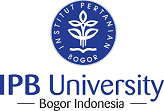MANGROVE LITTER-FALL STUDIES AT THE AJKWA ESTUARY IRIAN JAYA
Abstract
Litter traps were used to estimate Litter-fall production in two mangrove communities in the Ajkwa estuary, part of the PT. Freeport Indonesia project area. The two communities studied Included Bruguiera gymnorrhiza - Camptostemon schultzii Rhizophora apiculata (Site 1) and B. cylindrica- R. apiculata (Site 2). The period of study was from February 16, 1998 to October 27, 1998 for Site 1 and February 25, 1998 to December 12, 1998 for Site 2. Total annual Litter-fall for Site 1 and Site 2 was g/m2/yr and 744.35 g/m2/yr, respectively. For both communities Litter-fall consisted of leaves (61.5% of total litter production at Site 1 and 51.8% at Site 2), reproductive parts (20.5% at Ske 1 and 11.1% at Site 2) and twigs (18.0% at Site 1 and 37.1% at Site 2). The monthly rate of total litter production at Site 1 displayed two peaks during the study period (a major peak in March and a minor one In October) while Site 2 showed only a single peak to February. Monthly rates of production for both leaf and twig litters at both sites peaked only once during the study period while rates of Litter production from plant reproductive parts peaked twice. In both communities, the rate of twig litter production coincided with litter production from reproductive parts. During the sampling period, litter-fall rates varied substantially but were not significantly correlated with rainfall. However, the rate of twig litter production in both communities was significantly correlated with wind velocity.





